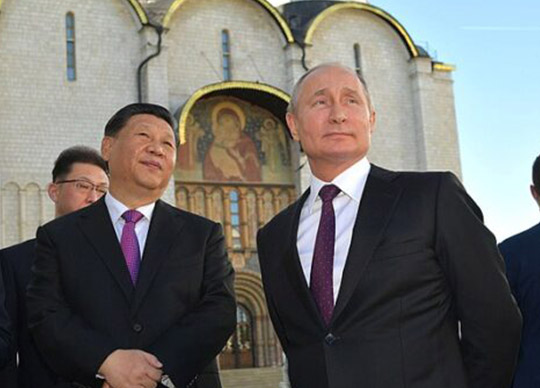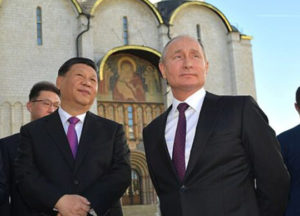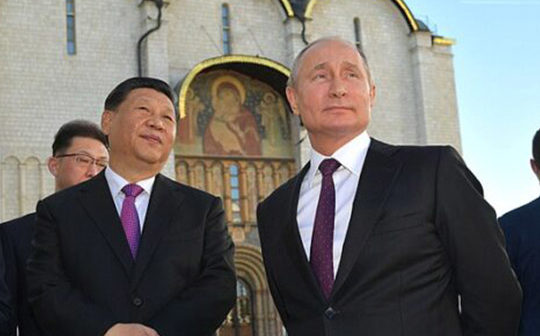

Xi Jinping and Vladimir Putin during tour of the Kremlin, image via Russian Presidential Press and Information Office
Published with permission, courtesy of the BESA Centre:BESA Center Perspectives Paper No. 2,090, July 7, 2021
EXECUTIVE SUMMARY: The Kremlin’s fixation on competing with the West might cost Russia dearly, as its clout in Central Asia is under strain from a rising China. Moscow will try to mitigate the tilting balance of power by applying methods of the post-liberal world order to the region. China and Russia might reach a condominium in which issues of economy and security are subdivided between them.
On May 12, 2021, China’s FM Wang Yi hosted the second China + Central Asia Foreign Ministers’ Meeting in the city of Xi’an. At the top of the agenda was Afghanistan, as China is worried about possible spillover into Central Asia and its eastern provinces.
But what matters most for the changing geopolitical landscape in Central Asia is China’s growing trade with the region and investment in critical local infrastructure. Because the region has historically been attached to the Russian heartland through major infrastructure, this trend effectively means Beijing is breaking into Central Asia’s “geographic prison.” New trade corridors through Central Asia are being established. The five regional states now have increasingly big opportunities to trade with the outside world—i.e., beyond Russia—through the Caspian, Iranian, and Chinese corridors.
Those trade corridors were a subject at the meeting in Xi’an, along with China’s promise of increased cooperation in agriculture, health and education, trade, energy, and transportation. Beijing also pledged to help Bishkek reduce its pile of debt and encouraged Kyrgyzstan to approve a railroad tying China directly to Uzbekistan. That project is meant to play a major role in connecting China with the Middle East and the South Caucasus.
The railroad has been beset by delays caused primarily by economic and political troubles in Kyrgyzstan, but also by Russia. Moscow fears that the new corridor will divert a significant portion of transit cargo from the Russian route. This concern is understandable. With each new economic agreement, the region is becoming more and more closely aligned with China.
The meeting in Xi’an also signaled that China is increasingly relying on small summits. Unwieldy get-togethers of states often fail to provide desired results, which caused Beijing to rethink its summit strategy. It is far more efficient for China to convene small gatherings at which it is dominant economically and therefore politically.
This strategy nips at Russia’s traditional influence in Central Asia and invites the question of what really constitutes Russian power in the region. The first element is its military capabilities, which are visible on its military bases in Tajikistan and Kyrgyzstan and intermittent military cooperation with other countries in the region. In the economic sphere, Russia’s reach is similarly strong. It is a major trade partner for the five states and a vital source of investment. Russia has also managed to partially engulf the region in security and economic initiatives like the Eurasian Economic Union and the Collective Security Treaty Organization. The region is also tied to Moscow culturally via the Russian language, which is the lingua franca.
Russia’s geopolitical position in the region is thus based on fundamental pillars, but China is poking at most all of them. It would be surprising if this did not precipitate a sense of grievance in Moscow. This likelihood has caused most Western analysts to posit an imminent geopolitical showdown between the two powers in the region.
The reality might be more nuanced. Theories built on hard power calculus between an emerging power (China) and a traditional power (Russia) are not entirely satisfying. They preclude us from building a coherent long-term understanding of dynamics between the two states. Moscow loathes Beijing’s growing influence, but its politicians are hesitant to say so explicitly. While the West largely dislikes the concept of spheres of influence and puts a strong emphasis on multilateralism, China, which is in an intense competition with America and wants to preclude a Western presence in Asia, seeks a deeper partnership with Russia. This being the case, the Russian political elite is inclined to watch Chinese initiatives in Central Asia—worrying though they may be—with less public outcry.
The nature of the emerging post-liberal world order could also provide critical answers for the emerging balance of power in Central Asia. As multilateralism—a critical pillar of the liberal world order—is under strain, this trend is widely used by emerging and openly revisionist powers to either upend altogether or rewrite some elements of the US-led order.
In the post-liberal world order, geopolitically important regions across Eurasia are increasingly co-managed by larger neighboring countries in an effort to limit the collective West’s influence. This extreme regionalization of geopolitically sensitive areas means that powers neighboring the territories in question seek to exclude third powers. Russia is pursuing this successfully in the South Caucasus, where, together with Turkey and partially Iran, it is working to dislodge the collective West. A similar process is taking place in Syria. This applies to the South China Sea, too, where Beijing is trying to settle territorial problems directly with its neighbors and without US involvement. Even the reaction to the latest round of fighting between Israel and Hamas indicated Russia’s, Turkey’s, and China’s increased willingness to distance the US from peace-building in the Middle East. Regionalization was at the heart of Russia’s Arctic policy as well, though there, Moscow had to agree to Chinese involvement due to pressure from Western sanctions.
Russia is also being pragmatic. Blocking other powers from establishing economic and political influence in what once was the Soviet Union would be a futile and perhaps even unwise political move. Russia lacks the resources to unilaterally dominate such a large space as Central Asia. Criticizing China openly would undermine relations with Beijing and hurt Moscow at the lowest point of bilateral ties with the collective West since the Cold War. Unable to forestall the growth of Chinese influence, Russia wants instead to take maximum advantage of Beijing’s emergence in Central Asia.
Thus the simplistic scenario of an inevitable rivalry between the two Eurasian powers in Central Asia belies more nuanced developments in the region and fails to place it within the context of a changing global order. Open China-Russia rivalry is unlikely, at least as long as the US continues to pressure them both. Beijing and Moscow will be more inclined to divide their influence in Central Asia. Russia will be less vocal about Chinese economic advances while playing the major security role.
This unofficial arrangement might not be optimal for the Kremlin. After all, Russia singlehandedly dominated the region for centuries. But dividing it with China would still be less damaging than confronting China. We may thus see an accord between two major powers motivated by illiberal visions and the desire to put limits on the West’s geopolitical clout.
Emil Avdaliani teaches history and international relations at Tbilisi State University and Ilia State University. He has worked for various international consulting companies and currently publishes articles on military and political developments across the former Soviet space.






